A Comprehensive Report on Disruptive Technology in the Business Sector
VerifiedAdded on 2022/12/19
|14
|3832
|76
Report
AI Summary
This report delves into the realm of disruptive technology, particularly its significance in the business sector, with a specific focus on supply chain operations. The report begins by defining disruptive technology and its impact on business practices, citing ride-sharing as a prime example. It explores the current uses of technology, including the Internet of Things, autonomous vehicles, drones, and 3D printing. The analysis presents three key arguments supporting the adoption of such technologies, while also discussing potential shortcomings, limitations, and other factors that could hinder a business from embracing these new solutions. The report also discusses the operational and financial ramifications of adopting disruptive technology, providing a comprehensive overview of its implications. The conclusion summarizes the key findings and highlights the importance of understanding and adapting to disruptive technologies in the modern business environment. The report also provides a deep dive into the key aspects and challenges of disruptive technology adoption in the business sector.
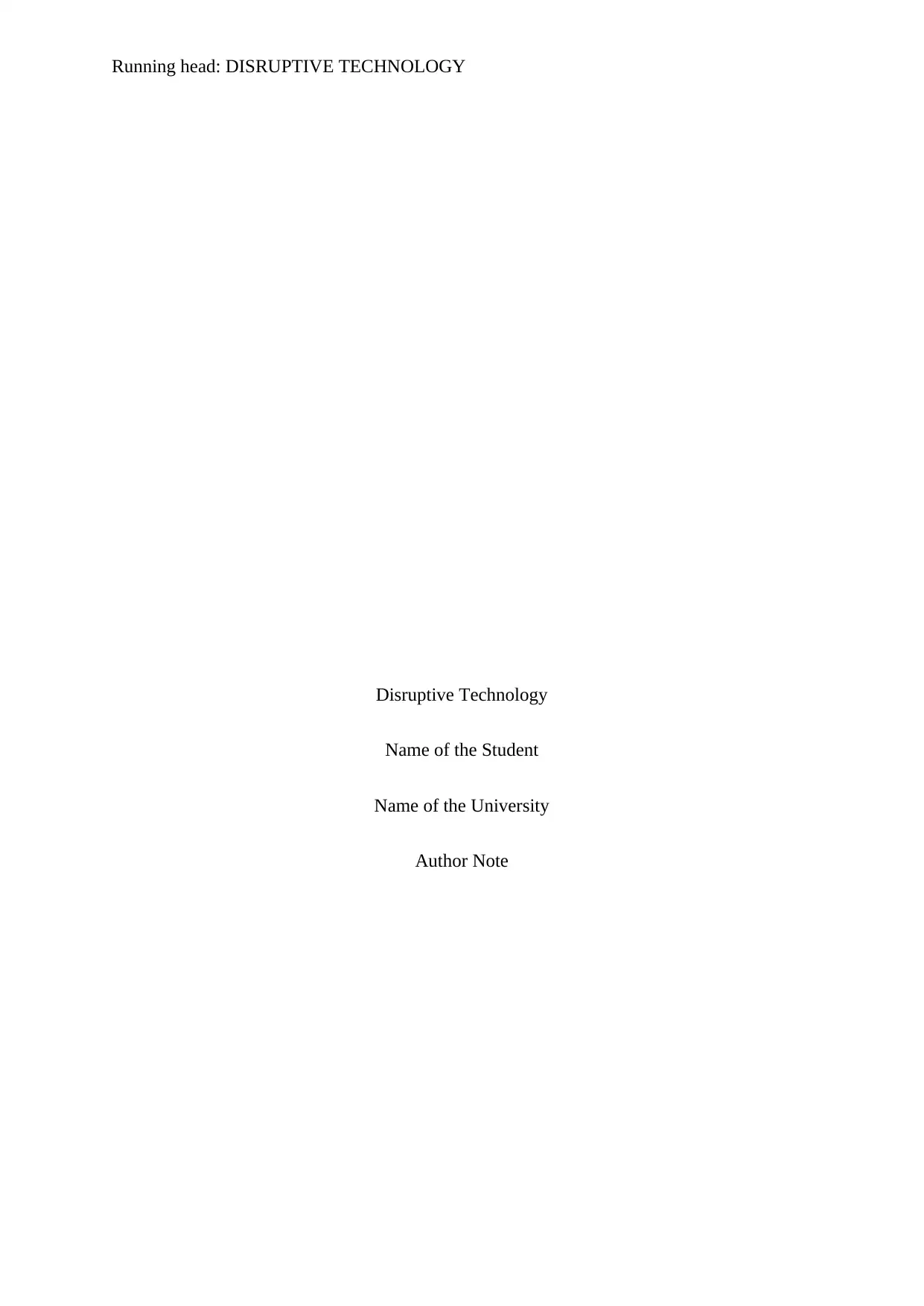
Running head: DISRUPTIVE TECHNOLOGY
Disruptive Technology
Name of the Student
Name of the University
Author Note
Disruptive Technology
Name of the Student
Name of the University
Author Note
Paraphrase This Document
Need a fresh take? Get an instant paraphrase of this document with our AI Paraphraser
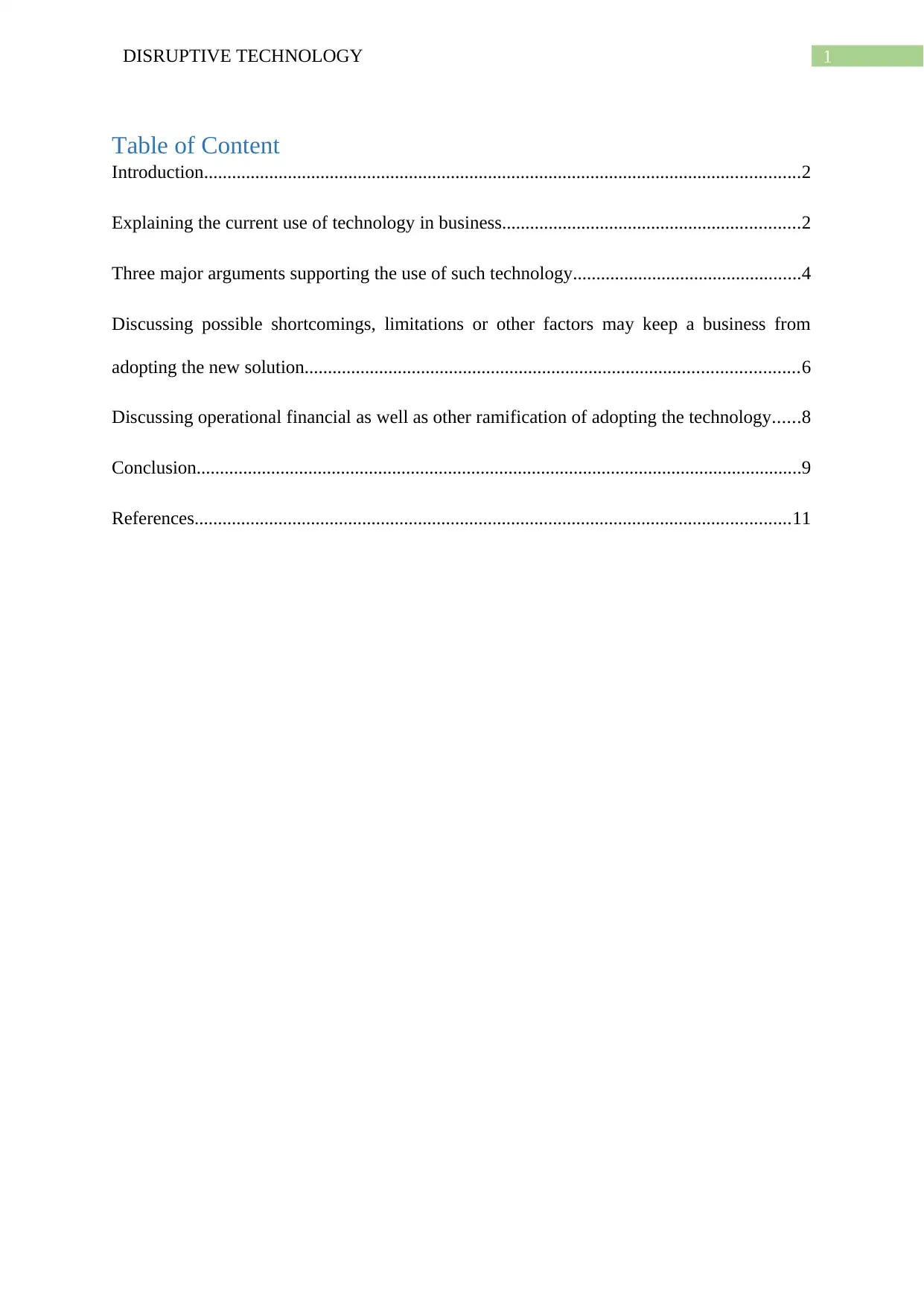
1DISRUPTIVE TECHNOLOGY
Table of Content
Introduction................................................................................................................................2
Explaining the current use of technology in business................................................................2
Three major arguments supporting the use of such technology.................................................4
Discussing possible shortcomings, limitations or other factors may keep a business from
adopting the new solution..........................................................................................................6
Discussing operational financial as well as other ramification of adopting the technology......8
Conclusion..................................................................................................................................9
References................................................................................................................................11
Table of Content
Introduction................................................................................................................................2
Explaining the current use of technology in business................................................................2
Three major arguments supporting the use of such technology.................................................4
Discussing possible shortcomings, limitations or other factors may keep a business from
adopting the new solution..........................................................................................................6
Discussing operational financial as well as other ramification of adopting the technology......8
Conclusion..................................................................................................................................9
References................................................................................................................................11
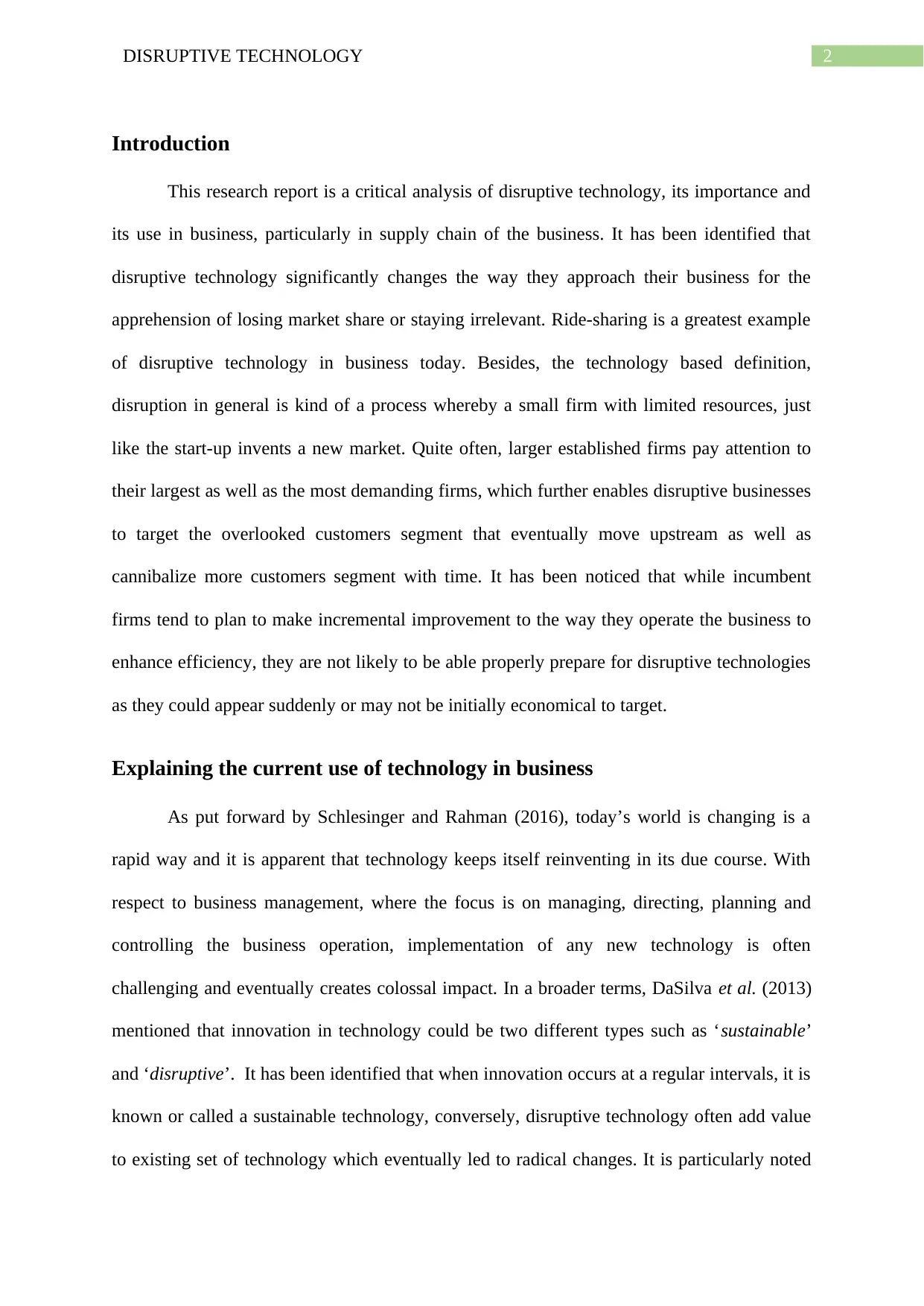
2DISRUPTIVE TECHNOLOGY
Introduction
This research report is a critical analysis of disruptive technology, its importance and
its use in business, particularly in supply chain of the business. It has been identified that
disruptive technology significantly changes the way they approach their business for the
apprehension of losing market share or staying irrelevant. Ride-sharing is a greatest example
of disruptive technology in business today. Besides, the technology based definition,
disruption in general is kind of a process whereby a small firm with limited resources, just
like the start-up invents a new market. Quite often, larger established firms pay attention to
their largest as well as the most demanding firms, which further enables disruptive businesses
to target the overlooked customers segment that eventually move upstream as well as
cannibalize more customers segment with time. It has been noticed that while incumbent
firms tend to plan to make incremental improvement to the way they operate the business to
enhance efficiency, they are not likely to be able properly prepare for disruptive technologies
as they could appear suddenly or may not be initially economical to target.
Explaining the current use of technology in business
As put forward by Schlesinger and Rahman (2016), today’s world is changing is a
rapid way and it is apparent that technology keeps itself reinventing in its due course. With
respect to business management, where the focus is on managing, directing, planning and
controlling the business operation, implementation of any new technology is often
challenging and eventually creates colossal impact. In a broader terms, DaSilva et al. (2013)
mentioned that innovation in technology could be two different types such as ‘sustainable’
and ‘disruptive’. It has been identified that when innovation occurs at a regular intervals, it is
known or called a sustainable technology, conversely, disruptive technology often add value
to existing set of technology which eventually led to radical changes. It is particularly noted
Introduction
This research report is a critical analysis of disruptive technology, its importance and
its use in business, particularly in supply chain of the business. It has been identified that
disruptive technology significantly changes the way they approach their business for the
apprehension of losing market share or staying irrelevant. Ride-sharing is a greatest example
of disruptive technology in business today. Besides, the technology based definition,
disruption in general is kind of a process whereby a small firm with limited resources, just
like the start-up invents a new market. Quite often, larger established firms pay attention to
their largest as well as the most demanding firms, which further enables disruptive businesses
to target the overlooked customers segment that eventually move upstream as well as
cannibalize more customers segment with time. It has been noticed that while incumbent
firms tend to plan to make incremental improvement to the way they operate the business to
enhance efficiency, they are not likely to be able properly prepare for disruptive technologies
as they could appear suddenly or may not be initially economical to target.
Explaining the current use of technology in business
As put forward by Schlesinger and Rahman (2016), today’s world is changing is a
rapid way and it is apparent that technology keeps itself reinventing in its due course. With
respect to business management, where the focus is on managing, directing, planning and
controlling the business operation, implementation of any new technology is often
challenging and eventually creates colossal impact. In a broader terms, DaSilva et al. (2013)
mentioned that innovation in technology could be two different types such as ‘sustainable’
and ‘disruptive’. It has been identified that when innovation occurs at a regular intervals, it is
known or called a sustainable technology, conversely, disruptive technology often add value
to existing set of technology which eventually led to radical changes. It is particularly noted
⊘ This is a preview!⊘
Do you want full access?
Subscribe today to unlock all pages.

Trusted by 1+ million students worldwide
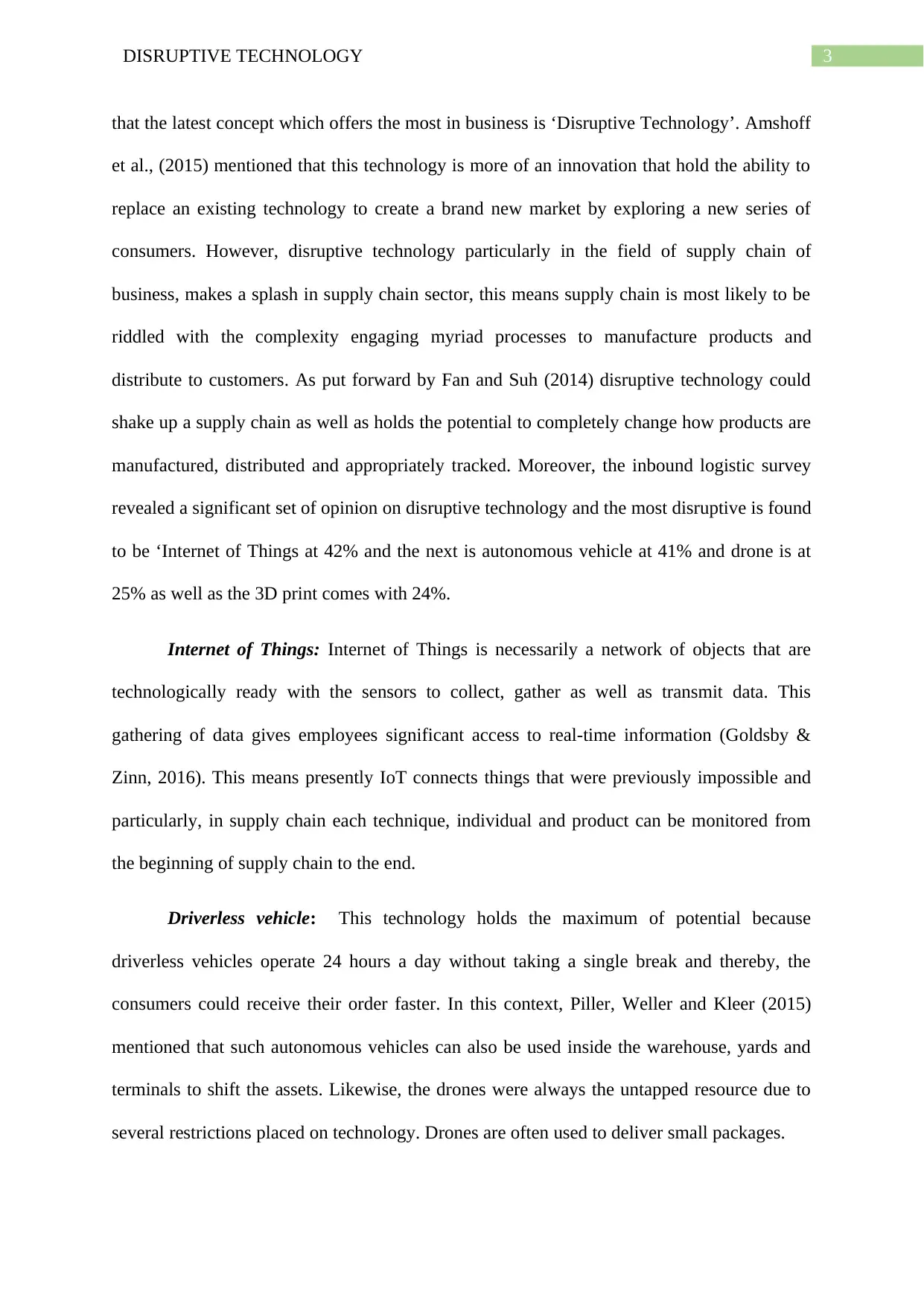
3DISRUPTIVE TECHNOLOGY
that the latest concept which offers the most in business is ‘Disruptive Technology’. Amshoff
et al., (2015) mentioned that this technology is more of an innovation that hold the ability to
replace an existing technology to create a brand new market by exploring a new series of
consumers. However, disruptive technology particularly in the field of supply chain of
business, makes a splash in supply chain sector, this means supply chain is most likely to be
riddled with the complexity engaging myriad processes to manufacture products and
distribute to customers. As put forward by Fan and Suh (2014) disruptive technology could
shake up a supply chain as well as holds the potential to completely change how products are
manufactured, distributed and appropriately tracked. Moreover, the inbound logistic survey
revealed a significant set of opinion on disruptive technology and the most disruptive is found
to be ‘Internet of Things at 42% and the next is autonomous vehicle at 41% and drone is at
25% as well as the 3D print comes with 24%.
Internet of Things: Internet of Things is necessarily a network of objects that are
technologically ready with the sensors to collect, gather as well as transmit data. This
gathering of data gives employees significant access to real-time information (Goldsby &
Zinn, 2016). This means presently IoT connects things that were previously impossible and
particularly, in supply chain each technique, individual and product can be monitored from
the beginning of supply chain to the end.
Driverless vehicle: This technology holds the maximum of potential because
driverless vehicles operate 24 hours a day without taking a single break and thereby, the
consumers could receive their order faster. In this context, Piller, Weller and Kleer (2015)
mentioned that such autonomous vehicles can also be used inside the warehouse, yards and
terminals to shift the assets. Likewise, the drones were always the untapped resource due to
several restrictions placed on technology. Drones are often used to deliver small packages.
that the latest concept which offers the most in business is ‘Disruptive Technology’. Amshoff
et al., (2015) mentioned that this technology is more of an innovation that hold the ability to
replace an existing technology to create a brand new market by exploring a new series of
consumers. However, disruptive technology particularly in the field of supply chain of
business, makes a splash in supply chain sector, this means supply chain is most likely to be
riddled with the complexity engaging myriad processes to manufacture products and
distribute to customers. As put forward by Fan and Suh (2014) disruptive technology could
shake up a supply chain as well as holds the potential to completely change how products are
manufactured, distributed and appropriately tracked. Moreover, the inbound logistic survey
revealed a significant set of opinion on disruptive technology and the most disruptive is found
to be ‘Internet of Things at 42% and the next is autonomous vehicle at 41% and drone is at
25% as well as the 3D print comes with 24%.
Internet of Things: Internet of Things is necessarily a network of objects that are
technologically ready with the sensors to collect, gather as well as transmit data. This
gathering of data gives employees significant access to real-time information (Goldsby &
Zinn, 2016). This means presently IoT connects things that were previously impossible and
particularly, in supply chain each technique, individual and product can be monitored from
the beginning of supply chain to the end.
Driverless vehicle: This technology holds the maximum of potential because
driverless vehicles operate 24 hours a day without taking a single break and thereby, the
consumers could receive their order faster. In this context, Piller, Weller and Kleer (2015)
mentioned that such autonomous vehicles can also be used inside the warehouse, yards and
terminals to shift the assets. Likewise, the drones were always the untapped resource due to
several restrictions placed on technology. Drones are often used to deliver small packages.
Paraphrase This Document
Need a fresh take? Get an instant paraphrase of this document with our AI Paraphraser
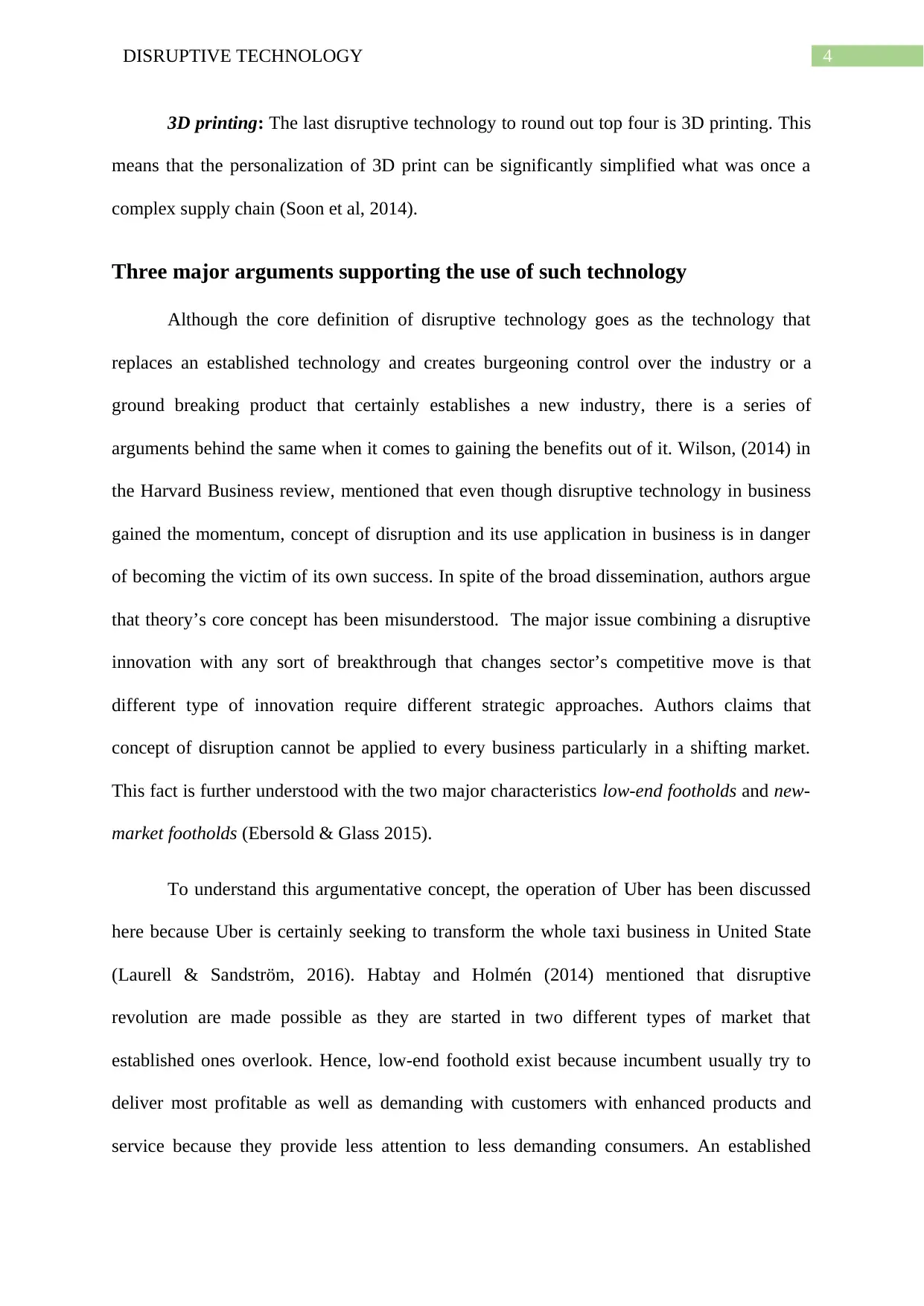
4DISRUPTIVE TECHNOLOGY
3D printing: The last disruptive technology to round out top four is 3D printing. This
means that the personalization of 3D print can be significantly simplified what was once a
complex supply chain (Soon et al, 2014).
Three major arguments supporting the use of such technology
Although the core definition of disruptive technology goes as the technology that
replaces an established technology and creates burgeoning control over the industry or a
ground breaking product that certainly establishes a new industry, there is a series of
arguments behind the same when it comes to gaining the benefits out of it. Wilson, (2014) in
the Harvard Business review, mentioned that even though disruptive technology in business
gained the momentum, concept of disruption and its use application in business is in danger
of becoming the victim of its own success. In spite of the broad dissemination, authors argue
that theory’s core concept has been misunderstood. The major issue combining a disruptive
innovation with any sort of breakthrough that changes sector’s competitive move is that
different type of innovation require different strategic approaches. Authors claims that
concept of disruption cannot be applied to every business particularly in a shifting market.
This fact is further understood with the two major characteristics low-end footholds and new-
market footholds (Ebersold & Glass 2015).
To understand this argumentative concept, the operation of Uber has been discussed
here because Uber is certainly seeking to transform the whole taxi business in United State
(Laurell & Sandström, 2016). Habtay and Holmén (2014) mentioned that disruptive
revolution are made possible as they are started in two different types of market that
established ones overlook. Hence, low-end foothold exist because incumbent usually try to
deliver most profitable as well as demanding with customers with enhanced products and
service because they provide less attention to less demanding consumers. An established
3D printing: The last disruptive technology to round out top four is 3D printing. This
means that the personalization of 3D print can be significantly simplified what was once a
complex supply chain (Soon et al, 2014).
Three major arguments supporting the use of such technology
Although the core definition of disruptive technology goes as the technology that
replaces an established technology and creates burgeoning control over the industry or a
ground breaking product that certainly establishes a new industry, there is a series of
arguments behind the same when it comes to gaining the benefits out of it. Wilson, (2014) in
the Harvard Business review, mentioned that even though disruptive technology in business
gained the momentum, concept of disruption and its use application in business is in danger
of becoming the victim of its own success. In spite of the broad dissemination, authors argue
that theory’s core concept has been misunderstood. The major issue combining a disruptive
innovation with any sort of breakthrough that changes sector’s competitive move is that
different type of innovation require different strategic approaches. Authors claims that
concept of disruption cannot be applied to every business particularly in a shifting market.
This fact is further understood with the two major characteristics low-end footholds and new-
market footholds (Ebersold & Glass 2015).
To understand this argumentative concept, the operation of Uber has been discussed
here because Uber is certainly seeking to transform the whole taxi business in United State
(Laurell & Sandström, 2016). Habtay and Holmén (2014) mentioned that disruptive
revolution are made possible as they are started in two different types of market that
established ones overlook. Hence, low-end foothold exist because incumbent usually try to
deliver most profitable as well as demanding with customers with enhanced products and
service because they provide less attention to less demanding consumers. An established

5DISRUPTIVE TECHNOLOGY
business’s offering can overshoot performance requirement of less demanding consumers and
this creates the opportunity for disrupters. On the contrary, in the case of new market-
footholds, disruptive business could create a market where none remain and they end up
turning non-consumers into consumers. So, the disruptive business takes place in this two
ways but if the operation of Uber is considered, business of Uber did not originate in either
one (Laurell & Sandström, 2016).
Another significant argument put forward by Gao et al., (2016) is that disruptive
innovation do not catch on with the mainstream customers if not the quality meets the
standards. It has been identified that disruption technology differentiates disruptive
innovation from what are known as ‘sustainable innovation’. Hence, sustainable innovation is
about making products better in the eye an incumbent’s existing consumers and here the
incumbent can be incremental advances or fundamental breakthrough, however, they all
allow businesses to sell more products to most profitable consumers. Conversely, the concept
of disruption is inferior by most incumbents’ consumers. This means the customers are not
likely to switch to new items as it relatively less expensive and rather they wait until its
quality increases enough to meet the needs. For example, booking a ride needs just few taps
on smartphone and here the payment is cashless as well as convenient and consumers can rate
the ride which ensures required standards. So, there are certain criteria but business must
follow instead of getting into vibes of success in disruptive technology.
Apart from the above two arguments, Valentine and Stewart (2013) stated that some
disruption might gain success while some certainly not. Authors of this article claim that a
common mistake is to pay attention to success achieved to claim that organization is
disruptive by virtue of its success. However, the success is not developed into the definition
of disruption. This means not every disruptive path could lead to success or not every
winning newcomer follows a disruptive path. Kiblawi (201,) also stated the fact that any
business’s offering can overshoot performance requirement of less demanding consumers and
this creates the opportunity for disrupters. On the contrary, in the case of new market-
footholds, disruptive business could create a market where none remain and they end up
turning non-consumers into consumers. So, the disruptive business takes place in this two
ways but if the operation of Uber is considered, business of Uber did not originate in either
one (Laurell & Sandström, 2016).
Another significant argument put forward by Gao et al., (2016) is that disruptive
innovation do not catch on with the mainstream customers if not the quality meets the
standards. It has been identified that disruption technology differentiates disruptive
innovation from what are known as ‘sustainable innovation’. Hence, sustainable innovation is
about making products better in the eye an incumbent’s existing consumers and here the
incumbent can be incremental advances or fundamental breakthrough, however, they all
allow businesses to sell more products to most profitable consumers. Conversely, the concept
of disruption is inferior by most incumbents’ consumers. This means the customers are not
likely to switch to new items as it relatively less expensive and rather they wait until its
quality increases enough to meet the needs. For example, booking a ride needs just few taps
on smartphone and here the payment is cashless as well as convenient and consumers can rate
the ride which ensures required standards. So, there are certain criteria but business must
follow instead of getting into vibes of success in disruptive technology.
Apart from the above two arguments, Valentine and Stewart (2013) stated that some
disruption might gain success while some certainly not. Authors of this article claim that a
common mistake is to pay attention to success achieved to claim that organization is
disruptive by virtue of its success. However, the success is not developed into the definition
of disruption. This means not every disruptive path could lead to success or not every
winning newcomer follows a disruptive path. Kiblawi (201,) also stated the fact that any
⊘ This is a preview!⊘
Do you want full access?
Subscribe today to unlock all pages.

Trusted by 1+ million students worldwide

6DISRUPTIVE TECHNOLOGY
number of internet-based retailers tend to pursue disruptive path in the last two decade but
only a few probably have prospered. It has been noted that failures are not just because of the
deficiencies of disruption theory, they are rather the limit markers for the implementation of
application. So, the disruption theory presented by Schlesinger and Rahman (2016) says very
little regarding how to have control over the foothold market compared to the action of
dealing with the odds and ignore the head-on competition.
Discussing possible shortcomings, limitations or other factors may keep a
business from adopting the new solution
There seems to be the core idea that disruptive is good, so any novel, new
implementation from a conventional business is most likely to be branded as disruptive for
the market value and this is kind of a shame because the realty of disruptive technology
comparatively easy to state but the benefits of disruptive technology can be far reaching and
it is enormously positive; negative possibilities also remain in large figure it could result in
serious concern and the loss of market. In this context, DaSilva et al., (2013) commented that
the mantra ‘disrupt or be disrupted could certainly misguide people. This means that the
incumbent companies should respond to disruption if that is taking place however they are
not supposed to overreact by dismantling a still-profitable business. It has been identified that
most big organizations are not comfortable with the disruptive innovations because such
innovations do not satisfy their existing needs. Big organizations only pay attention to the
demands of mainstream consumers. This means if the consumers wish better products, they
will keep evolving the product. Such kind of in-house disruptive innovation could burn a lot
of resources away from sustainable innovation and this is often required to fight against
existing competitors. Consequently, such companies are held captive by the most profitable
consumers, preventing them from pursuing disruptions.
number of internet-based retailers tend to pursue disruptive path in the last two decade but
only a few probably have prospered. It has been noted that failures are not just because of the
deficiencies of disruption theory, they are rather the limit markers for the implementation of
application. So, the disruption theory presented by Schlesinger and Rahman (2016) says very
little regarding how to have control over the foothold market compared to the action of
dealing with the odds and ignore the head-on competition.
Discussing possible shortcomings, limitations or other factors may keep a
business from adopting the new solution
There seems to be the core idea that disruptive is good, so any novel, new
implementation from a conventional business is most likely to be branded as disruptive for
the market value and this is kind of a shame because the realty of disruptive technology
comparatively easy to state but the benefits of disruptive technology can be far reaching and
it is enormously positive; negative possibilities also remain in large figure it could result in
serious concern and the loss of market. In this context, DaSilva et al., (2013) commented that
the mantra ‘disrupt or be disrupted could certainly misguide people. This means that the
incumbent companies should respond to disruption if that is taking place however they are
not supposed to overreact by dismantling a still-profitable business. It has been identified that
most big organizations are not comfortable with the disruptive innovations because such
innovations do not satisfy their existing needs. Big organizations only pay attention to the
demands of mainstream consumers. This means if the consumers wish better products, they
will keep evolving the product. Such kind of in-house disruptive innovation could burn a lot
of resources away from sustainable innovation and this is often required to fight against
existing competitors. Consequently, such companies are held captive by the most profitable
consumers, preventing them from pursuing disruptions.
Paraphrase This Document
Need a fresh take? Get an instant paraphrase of this document with our AI Paraphraser
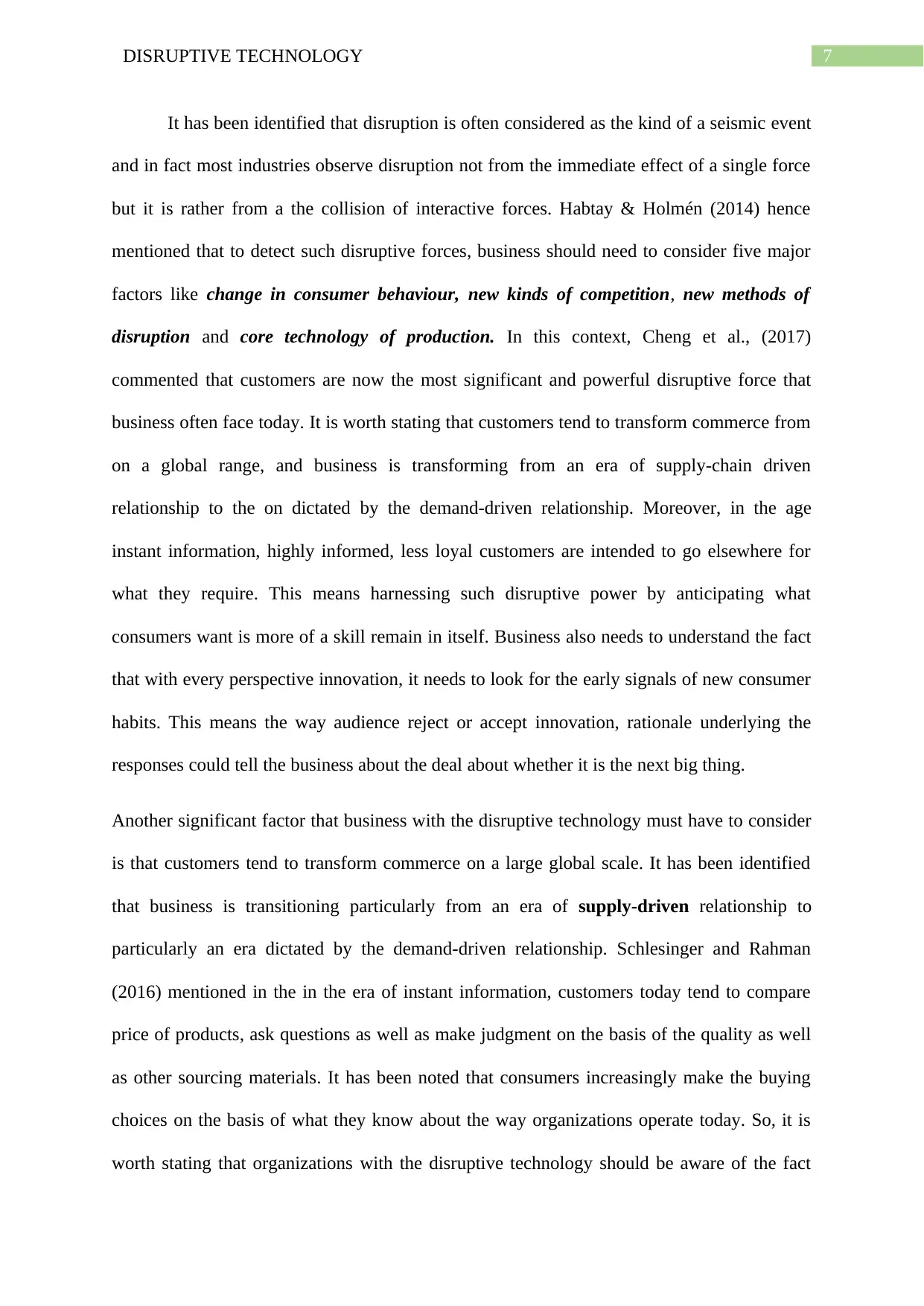
7DISRUPTIVE TECHNOLOGY
It has been identified that disruption is often considered as the kind of a seismic event
and in fact most industries observe disruption not from the immediate effect of a single force
but it is rather from a the collision of interactive forces. Habtay & Holmén (2014) hence
mentioned that to detect such disruptive forces, business should need to consider five major
factors like change in consumer behaviour, new kinds of competition, new methods of
disruption and core technology of production. In this context, Cheng et al., (2017)
commented that customers are now the most significant and powerful disruptive force that
business often face today. It is worth stating that customers tend to transform commerce from
on a global range, and business is transforming from an era of supply-chain driven
relationship to the on dictated by the demand-driven relationship. Moreover, in the age
instant information, highly informed, less loyal customers are intended to go elsewhere for
what they require. This means harnessing such disruptive power by anticipating what
consumers want is more of a skill remain in itself. Business also needs to understand the fact
that with every perspective innovation, it needs to look for the early signals of new consumer
habits. This means the way audience reject or accept innovation, rationale underlying the
responses could tell the business about the deal about whether it is the next big thing.
Another significant factor that business with the disruptive technology must have to consider
is that customers tend to transform commerce on a large global scale. It has been identified
that business is transitioning particularly from an era of supply-driven relationship to
particularly an era dictated by the demand-driven relationship. Schlesinger and Rahman
(2016) mentioned in the in the era of instant information, customers today tend to compare
price of products, ask questions as well as make judgment on the basis of the quality as well
as other sourcing materials. It has been noted that consumers increasingly make the buying
choices on the basis of what they know about the way organizations operate today. So, it is
worth stating that organizations with the disruptive technology should be aware of the fact
It has been identified that disruption is often considered as the kind of a seismic event
and in fact most industries observe disruption not from the immediate effect of a single force
but it is rather from a the collision of interactive forces. Habtay & Holmén (2014) hence
mentioned that to detect such disruptive forces, business should need to consider five major
factors like change in consumer behaviour, new kinds of competition, new methods of
disruption and core technology of production. In this context, Cheng et al., (2017)
commented that customers are now the most significant and powerful disruptive force that
business often face today. It is worth stating that customers tend to transform commerce from
on a global range, and business is transforming from an era of supply-chain driven
relationship to the on dictated by the demand-driven relationship. Moreover, in the age
instant information, highly informed, less loyal customers are intended to go elsewhere for
what they require. This means harnessing such disruptive power by anticipating what
consumers want is more of a skill remain in itself. Business also needs to understand the fact
that with every perspective innovation, it needs to look for the early signals of new consumer
habits. This means the way audience reject or accept innovation, rationale underlying the
responses could tell the business about the deal about whether it is the next big thing.
Another significant factor that business with the disruptive technology must have to consider
is that customers tend to transform commerce on a large global scale. It has been identified
that business is transitioning particularly from an era of supply-driven relationship to
particularly an era dictated by the demand-driven relationship. Schlesinger and Rahman
(2016) mentioned in the in the era of instant information, customers today tend to compare
price of products, ask questions as well as make judgment on the basis of the quality as well
as other sourcing materials. It has been noted that consumers increasingly make the buying
choices on the basis of what they know about the way organizations operate today. So, it is
worth stating that organizations with the disruptive technology should be aware of the fact

8DISRUPTIVE TECHNOLOGY
that most of the large businesses that often harness power by predicting what consumers want
requires suitable skills. There may some incidents where entrepreneurial as well as the social
vision could fit appropriately with evolving consumers’ wants and behaviours such as the
social media example, however, there are many cases where technology solutions have often
remained flat.
(Amshoff et al., (2015) stated the fact that technology which continue to be both a source of
disruption and significant way of transforming disruption into an opportunity. Hence, the
barrier could be about how to track, develop, build, gain and carry out the appropriate
winning technology. On the contrary, those who sense the disruption first, are most lily to
gain the opportunity to drive it, rearrange the way industry emerges and gain the advantages.
Discussing operational financial as well as other ramification of adopting
the technology
It has been identified that disruptive technology is most likely to flatten the typical
hierarchical structure of the organization by enhancing the visibility of senior management
and that could make the senior management more accessible. This means outsourcing a
previously in-house competitors like the IT systems to could networking organizations place
people’s job at risk. Goldsby and Zinn (2016) mentioned the fact that technology plays a
great role in the foundation of supply chain of prominent organizations. According to Fan and
Suh (2014) Wal-Mart holds the largest information technology infrastructure of any sort of
private firm in the world and it has been learnt that its state of the art technology as well as
network design could allow Wal-Mart to perfectly forecast the demand and anticipate the
level of inventory as well as create an efficient transportation routes and deal with the
customer relationship and logistics of service response.
that most of the large businesses that often harness power by predicting what consumers want
requires suitable skills. There may some incidents where entrepreneurial as well as the social
vision could fit appropriately with evolving consumers’ wants and behaviours such as the
social media example, however, there are many cases where technology solutions have often
remained flat.
(Amshoff et al., (2015) stated the fact that technology which continue to be both a source of
disruption and significant way of transforming disruption into an opportunity. Hence, the
barrier could be about how to track, develop, build, gain and carry out the appropriate
winning technology. On the contrary, those who sense the disruption first, are most lily to
gain the opportunity to drive it, rearrange the way industry emerges and gain the advantages.
Discussing operational financial as well as other ramification of adopting
the technology
It has been identified that disruptive technology is most likely to flatten the typical
hierarchical structure of the organization by enhancing the visibility of senior management
and that could make the senior management more accessible. This means outsourcing a
previously in-house competitors like the IT systems to could networking organizations place
people’s job at risk. Goldsby and Zinn (2016) mentioned the fact that technology plays a
great role in the foundation of supply chain of prominent organizations. According to Fan and
Suh (2014) Wal-Mart holds the largest information technology infrastructure of any sort of
private firm in the world and it has been learnt that its state of the art technology as well as
network design could allow Wal-Mart to perfectly forecast the demand and anticipate the
level of inventory as well as create an efficient transportation routes and deal with the
customer relationship and logistics of service response.
⊘ This is a preview!⊘
Do you want full access?
Subscribe today to unlock all pages.

Trusted by 1+ million students worldwide
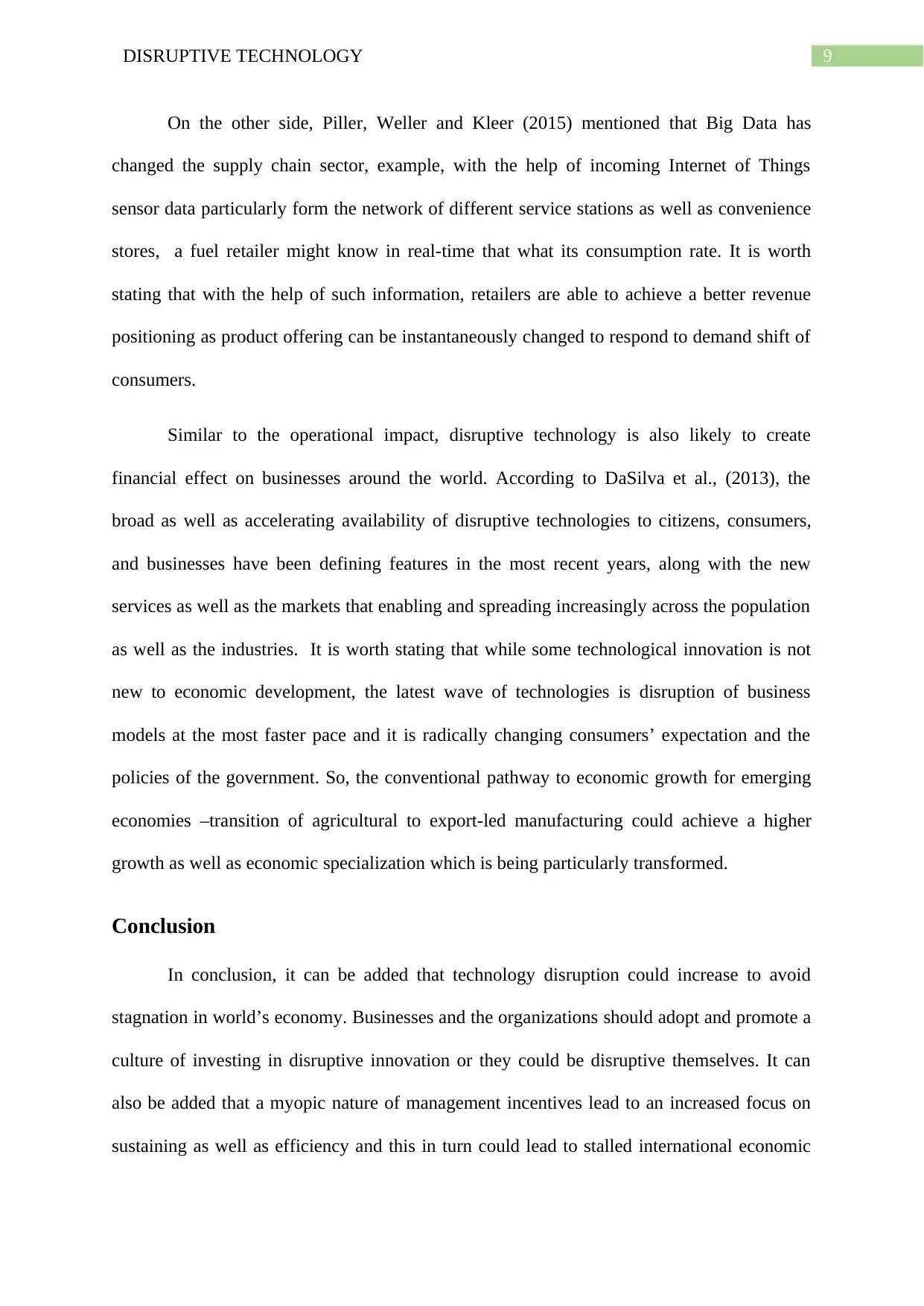
9DISRUPTIVE TECHNOLOGY
On the other side, Piller, Weller and Kleer (2015) mentioned that Big Data has
changed the supply chain sector, example, with the help of incoming Internet of Things
sensor data particularly form the network of different service stations as well as convenience
stores, a fuel retailer might know in real-time that what its consumption rate. It is worth
stating that with the help of such information, retailers are able to achieve a better revenue
positioning as product offering can be instantaneously changed to respond to demand shift of
consumers.
Similar to the operational impact, disruptive technology is also likely to create
financial effect on businesses around the world. According to DaSilva et al., (2013), the
broad as well as accelerating availability of disruptive technologies to citizens, consumers,
and businesses have been defining features in the most recent years, along with the new
services as well as the markets that enabling and spreading increasingly across the population
as well as the industries. It is worth stating that while some technological innovation is not
new to economic development, the latest wave of technologies is disruption of business
models at the most faster pace and it is radically changing consumers’ expectation and the
policies of the government. So, the conventional pathway to economic growth for emerging
economies –transition of agricultural to export-led manufacturing could achieve a higher
growth as well as economic specialization which is being particularly transformed.
Conclusion
In conclusion, it can be added that technology disruption could increase to avoid
stagnation in world’s economy. Businesses and the organizations should adopt and promote a
culture of investing in disruptive innovation or they could be disruptive themselves. It can
also be added that a myopic nature of management incentives lead to an increased focus on
sustaining as well as efficiency and this in turn could lead to stalled international economic
On the other side, Piller, Weller and Kleer (2015) mentioned that Big Data has
changed the supply chain sector, example, with the help of incoming Internet of Things
sensor data particularly form the network of different service stations as well as convenience
stores, a fuel retailer might know in real-time that what its consumption rate. It is worth
stating that with the help of such information, retailers are able to achieve a better revenue
positioning as product offering can be instantaneously changed to respond to demand shift of
consumers.
Similar to the operational impact, disruptive technology is also likely to create
financial effect on businesses around the world. According to DaSilva et al., (2013), the
broad as well as accelerating availability of disruptive technologies to citizens, consumers,
and businesses have been defining features in the most recent years, along with the new
services as well as the markets that enabling and spreading increasingly across the population
as well as the industries. It is worth stating that while some technological innovation is not
new to economic development, the latest wave of technologies is disruption of business
models at the most faster pace and it is radically changing consumers’ expectation and the
policies of the government. So, the conventional pathway to economic growth for emerging
economies –transition of agricultural to export-led manufacturing could achieve a higher
growth as well as economic specialization which is being particularly transformed.
Conclusion
In conclusion, it can be added that technology disruption could increase to avoid
stagnation in world’s economy. Businesses and the organizations should adopt and promote a
culture of investing in disruptive innovation or they could be disruptive themselves. It can
also be added that a myopic nature of management incentives lead to an increased focus on
sustaining as well as efficiency and this in turn could lead to stalled international economic
Paraphrase This Document
Need a fresh take? Get an instant paraphrase of this document with our AI Paraphraser
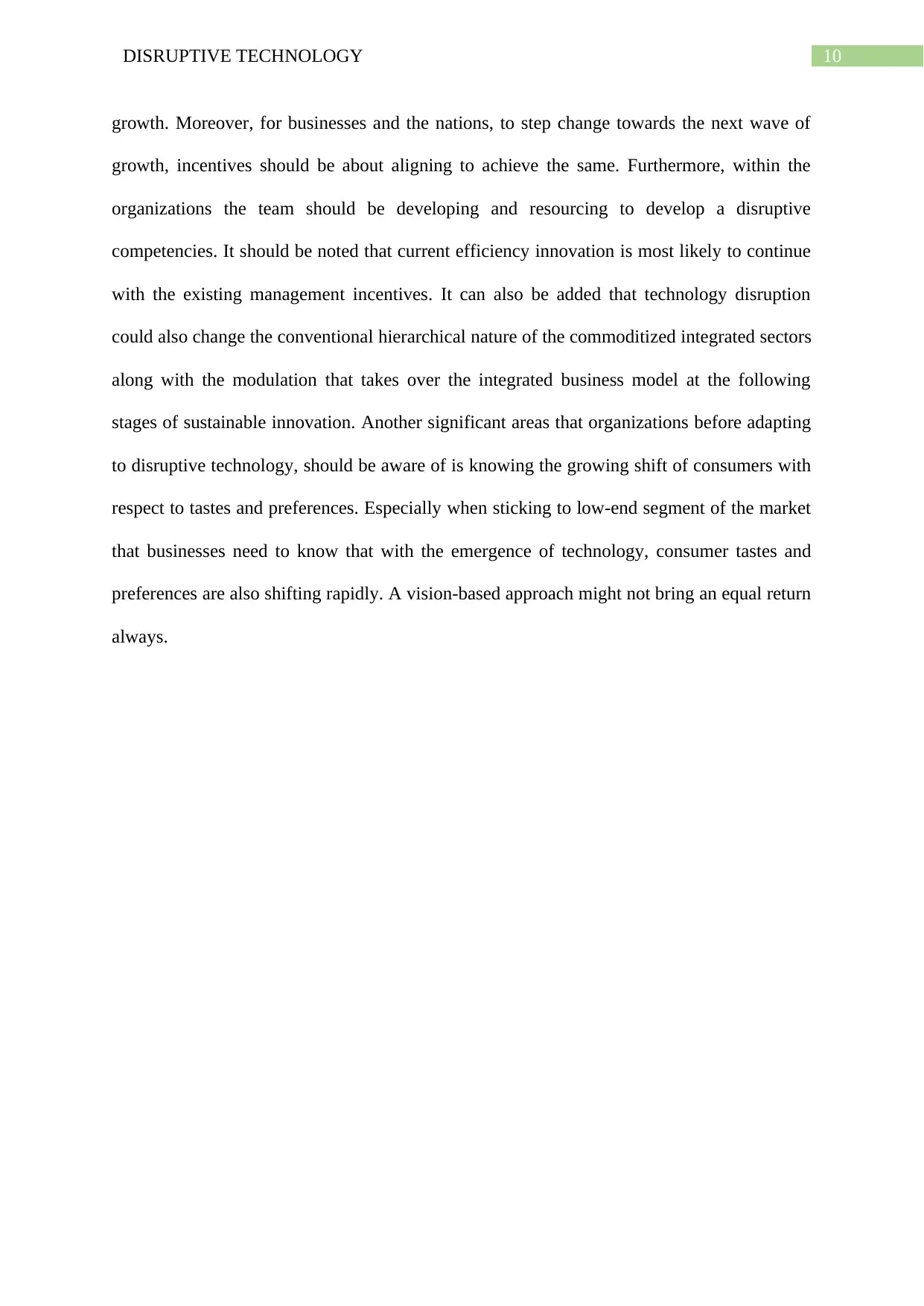
10DISRUPTIVE TECHNOLOGY
growth. Moreover, for businesses and the nations, to step change towards the next wave of
growth, incentives should be about aligning to achieve the same. Furthermore, within the
organizations the team should be developing and resourcing to develop a disruptive
competencies. It should be noted that current efficiency innovation is most likely to continue
with the existing management incentives. It can also be added that technology disruption
could also change the conventional hierarchical nature of the commoditized integrated sectors
along with the modulation that takes over the integrated business model at the following
stages of sustainable innovation. Another significant areas that organizations before adapting
to disruptive technology, should be aware of is knowing the growing shift of consumers with
respect to tastes and preferences. Especially when sticking to low-end segment of the market
that businesses need to know that with the emergence of technology, consumer tastes and
preferences are also shifting rapidly. A vision-based approach might not bring an equal return
always.
growth. Moreover, for businesses and the nations, to step change towards the next wave of
growth, incentives should be about aligning to achieve the same. Furthermore, within the
organizations the team should be developing and resourcing to develop a disruptive
competencies. It should be noted that current efficiency innovation is most likely to continue
with the existing management incentives. It can also be added that technology disruption
could also change the conventional hierarchical nature of the commoditized integrated sectors
along with the modulation that takes over the integrated business model at the following
stages of sustainable innovation. Another significant areas that organizations before adapting
to disruptive technology, should be aware of is knowing the growing shift of consumers with
respect to tastes and preferences. Especially when sticking to low-end segment of the market
that businesses need to know that with the emergence of technology, consumer tastes and
preferences are also shifting rapidly. A vision-based approach might not bring an equal return
always.
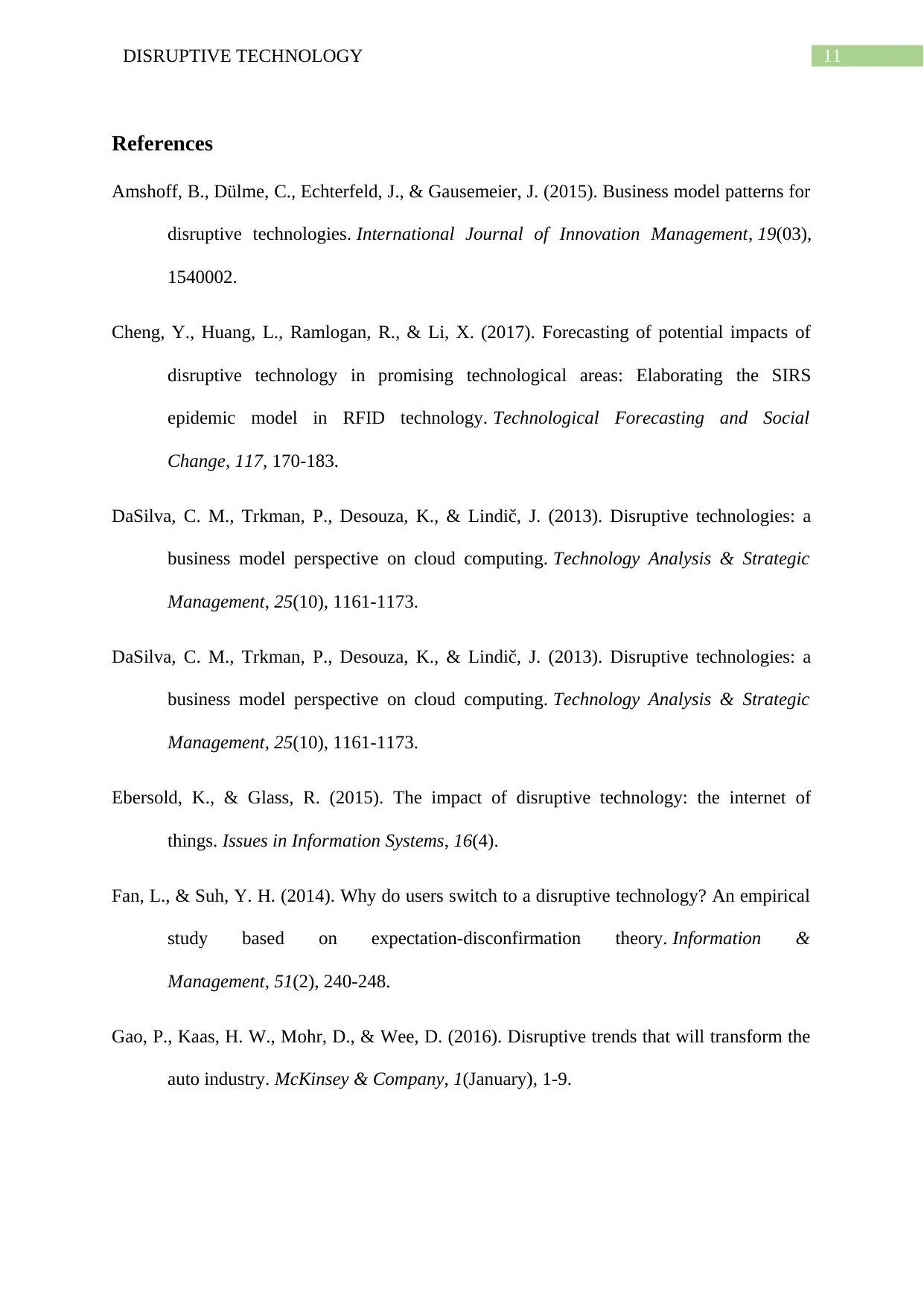
11DISRUPTIVE TECHNOLOGY
References
Amshoff, B., Dülme, C., Echterfeld, J., & Gausemeier, J. (2015). Business model patterns for
disruptive technologies. International Journal of Innovation Management, 19(03),
1540002.
Cheng, Y., Huang, L., Ramlogan, R., & Li, X. (2017). Forecasting of potential impacts of
disruptive technology in promising technological areas: Elaborating the SIRS
epidemic model in RFID technology. Technological Forecasting and Social
Change, 117, 170-183.
DaSilva, C. M., Trkman, P., Desouza, K., & Lindič, J. (2013). Disruptive technologies: a
business model perspective on cloud computing. Technology Analysis & Strategic
Management, 25(10), 1161-1173.
DaSilva, C. M., Trkman, P., Desouza, K., & Lindič, J. (2013). Disruptive technologies: a
business model perspective on cloud computing. Technology Analysis & Strategic
Management, 25(10), 1161-1173.
Ebersold, K., & Glass, R. (2015). The impact of disruptive technology: the internet of
things. Issues in Information Systems, 16(4).
Fan, L., & Suh, Y. H. (2014). Why do users switch to a disruptive technology? An empirical
study based on expectation-disconfirmation theory. Information &
Management, 51(2), 240-248.
Gao, P., Kaas, H. W., Mohr, D., & Wee, D. (2016). Disruptive trends that will transform the
auto industry. McKinsey & Company, 1(January), 1-9.
References
Amshoff, B., Dülme, C., Echterfeld, J., & Gausemeier, J. (2015). Business model patterns for
disruptive technologies. International Journal of Innovation Management, 19(03),
1540002.
Cheng, Y., Huang, L., Ramlogan, R., & Li, X. (2017). Forecasting of potential impacts of
disruptive technology in promising technological areas: Elaborating the SIRS
epidemic model in RFID technology. Technological Forecasting and Social
Change, 117, 170-183.
DaSilva, C. M., Trkman, P., Desouza, K., & Lindič, J. (2013). Disruptive technologies: a
business model perspective on cloud computing. Technology Analysis & Strategic
Management, 25(10), 1161-1173.
DaSilva, C. M., Trkman, P., Desouza, K., & Lindič, J. (2013). Disruptive technologies: a
business model perspective on cloud computing. Technology Analysis & Strategic
Management, 25(10), 1161-1173.
Ebersold, K., & Glass, R. (2015). The impact of disruptive technology: the internet of
things. Issues in Information Systems, 16(4).
Fan, L., & Suh, Y. H. (2014). Why do users switch to a disruptive technology? An empirical
study based on expectation-disconfirmation theory. Information &
Management, 51(2), 240-248.
Gao, P., Kaas, H. W., Mohr, D., & Wee, D. (2016). Disruptive trends that will transform the
auto industry. McKinsey & Company, 1(January), 1-9.
⊘ This is a preview!⊘
Do you want full access?
Subscribe today to unlock all pages.

Trusted by 1+ million students worldwide
1 out of 14
Related Documents
Your All-in-One AI-Powered Toolkit for Academic Success.
+13062052269
info@desklib.com
Available 24*7 on WhatsApp / Email
![[object Object]](/_next/static/media/star-bottom.7253800d.svg)
Unlock your academic potential
Copyright © 2020–2025 A2Z Services. All Rights Reserved. Developed and managed by ZUCOL.




